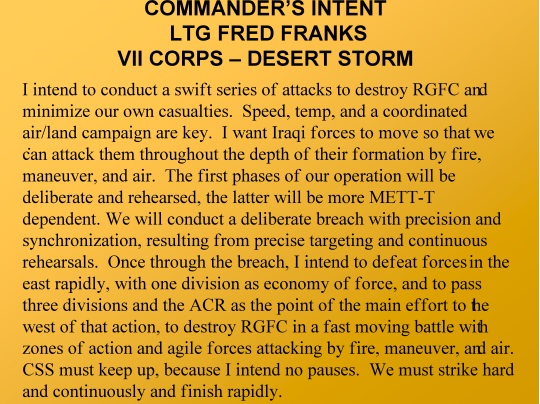Tactics 101: 027. Commander’s Intent

What is Not in Intent!
There are two elements that should not be included in intent that used to be staples of intents. First, the commander does not address risk in the intent. He does not tell his subordinates what risk he is willing to assume in the operation. Doctrinally, risk is discussed in the commander’s guidance given during course of action development. During guidance, the commander will address risk for each course of action he wants his staff to develop. Second, and again for emphasis, the commander does not articulate the method or the “how.” This is in the concept of operation in the operations order.
BULLETS OR SENTENCES
Before we share some examples of doctrinal commander’s intents, let’s briefly talk the display of the intent. Although doctrine prescribes intents being written in sentence and paragraph form; there are many commanders who craft their intents in bullet form. We are not going to say which is better – it is commander’s discretion. Some say sentence form seems to flow better. Others say the bullet form enables the commander to place more emphasis on his words.
WHERE IS INTENT LOCATED IN AN OPERATIONS ORDER?
Let’s address one more loose end. You may be asking where is intent placed in a written operations order? The answer is in paragraph 3 (Execution) of the order. Before paragraph 3a (concept of operation), the commander’s intent is displayed. It looks like this:
3. EXECUTION. Intent:
a. Concept of Operations.
Thus, as it should be, the intent is between the mission statement (paragraph 2) and the concept of operation.
EXAMPLE TIME
Let’s look at a couple of intents – one sentence/paragraph style and one bullet style. Before we start, these are not school solutions. We personally do not believe in perfect school solutions. These however, are pretty good in addressing the components and the power of intent.
SENTENCE/PARAGRAPH STYLE:
We must provide the time and maneuver space needed for the commitment of the X Corps main effort, 23 AD, by defending to defeat the 2D Mech Army. Key tasks to achieve success are: deny Dakotan reconnaissance the ability to determine our array of forces, disrupt the ability of the AAG from massing indirect fires against our main effort, and delay the commitment of his 2d echelon division. At endstate, the 2d Mech Army is defeated north of PL BLACK with no battalion sized penetrations of PL BLACK; we will have maintained the viability of the bridge crossing sites over the Kansas River within our area of operations, the civilian populace is not located where they can hinder future friendly maneuver, and we will have retained sufficient combat power to defend against the Army Group 2d operational echelon (4TA) or postured to attack with one brigade within 12 hours.
BULLET STYLE:
PURPOSE: Our ultimate purpose is to facilitate regime change in Iraq.
KEY TASKS: I see the following as key tasks in achieving this purpose:
- Defeat the Republican Guard and Special Republican Guard.
- Destroy enemy forces along the axis of advance.
- Isolate and bypass urban areas along the axis of advance IOT maintain tempo and limit collateral damage.
- Secure logistics areas vicinity of AS SAMAWAH, ASH SHINAFIYAH, AN NAJAF, and KARBALA.
- Secure the KARBALA GAP to allow maneuver.
- Isolate BAGHDAD from the west while 1 MEF isolates from the east.
ENDSTATE: Baghdad isolated, Iraqi forces defeated in Corps AO, Iraqi
populace willingly cooperating, Corps units prepared for further combat
operations and transitioning to post hostility operations.
[continued on next page]


The first bullet point in the intent should be eliminated, as what forces are in our path is of “special interests” not ours.
Last thing we need is to grabbing ourselves because we are up against the Republican or Special Republican Guard.
Great article otherwise!
Re commander’s intent: nice to see that this surprisingly modern management concept, which is over a hundred years old, is getting the wide acceptance it deserves.
I have a couple of questions, though!
First question: How is ‘commander’s intent’ different from ‘mission’? Cannot /shouldn’t it be integrated?
Second question: if in your example on page 2 there had been two instead of one scout sergeant, positioned on the opposite flanks of the battalion’s advance and they had both assessed the situation and radioed in to remedy the advance but towards their own (respective) positions, how would that situation be resolved? Company commander who receives the radio call decides, battalion decides?
Mission: toss bad guys out of zone
Intent:
-and not get lost while doing this
-and conserve force
-and do this in 24 hours.
-etc.
You could integrate these concepts – but reasons are given to make a more complete, personal statement.
Re: 2 courses of action available to subordinate commander.
The man on the spot ( Company commander ) decides – given that Battalion Commander had already stated his intent, and that at least one of the 2 scouts was out of contact with TF command anyway.
The idea here is that you and your Command can keep going even if Comms are inoperative. Sherman and Grant would not necessarily be able to communicate with each other anyway.
Hello. I want to ask concerning one of MDMP step- WARAMING. How to create Decision Support template and Decision Support Matrix?
Thanks.
Best regards.